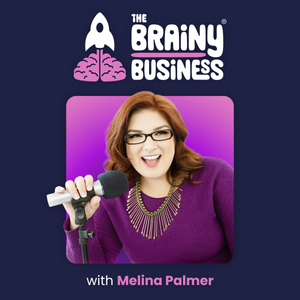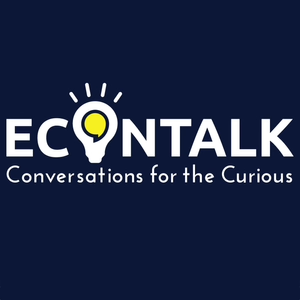
176. Reframing Annoying Disruptions to Support Innovation, with Adam Hansen, coauthor of Outsmart Your Instincts
10/29/21 • 50 min
1 Listener
Have you ever had a disruption in your routine – moving to a new house, taking a new route to work – and found yourself exhausted every day?
This is common when our habits are upended (the subconscious can’t use its rules anymore so your conscious is having to do a lot more work!). And while it may feel annoying, this is also a great opportunity to innovate and change your life for the better.
Today, I’m joined by Adam Hansen, VP of behavioral innovation at Ideas To Go and coauthor of Outsmart Your Instincts who happened to be in the midst of a move, so we talk about how to reframe an annoying disruption in habits to make it work for you. We also discuss the curse of knowledge and how it impacts businesses, risks of omission versus risks of commission, and other fun behavioral goodness sprinkled throughout (including my new favorite term of being an “omnivore of information”). Listen now...
Show Notes:
- [00:07] In today’s episode, I’m excited to introduce you to Adam Hansen, VP of behavioral innovation at Ideas To Go and coauthor of Outsmart Your Instincts.
- [03:18] Adam shares about himself and his background. He always knew that innovation would be part of his career.
- [05:18] When working on the book, they started looking at all the cognitive biases to figure out which ones were causing most of the mayhem in innovation.
- [06:16] If you adopt the behavioral innovation approach, you can see three to four times improvement in performance and quality of ideas very early on in innovation. You can get to better ideas faster.
- [09:01] All of the thousands of small decisions we make every day that have been automated are lost when you move. Each little thing is so minor that we don’t realize what the cumulative effect of all those small decisions is.
- [10:02] It is important for us to automate everything we can.
- [12:19] It is impossible for us to place ourselves fully back in the shoes of our first-time clients. Our version of dumbing things down to meet them where they are is still going to be more advanced than where we need to get to. We can work on this by following up with first-time clients and asking what you could have done better.
- [13:46] There is so much more jargon in your business than you think there is.
- [16:10] Our need for tangibility is much greater than we assume. Most people need help to break down abstraction. The more tangible you can be the better.
- [18:13] The curse of knowledge is the idea that once you become knowledgeable in a given area, you can't unknow what you know and you can’t fully place yourself back in the shoes of the subject.
- [23:27] Negativity Bias is the idea from our ancestors of thinking of all novelty as threat and not opportunity.
- [25:12] Especially in innovation, we need to be as opportunity minded as possible. We need to be aware of threats and take smart action to minimize and mitigate those threats.
- [27:43] When we are in moments of threat, to still be able to take swift decisive action is fantastic (and sometimes life-saving!)
- [28:29] The research shows that negativity can appear super profound. Too often we are shooting down ideas and not coming up with alternatives. That is not progress.
- [30:31] We are predisposed to go toward the negative any time a new idea comes up.
- [31:38] The more you can value ideas early on for their provocative value rather than for their immediate merits the better. Then you are in a better frame of mind to take on the negatives.
- [33:54] When you approach challenges to problems in this way, there is real value. The language is brilliant, priming to get people to deal with problems and concerns in a much better way.
- [35:10] If you are an optimistic person it doesn’t mean that you don’t have a negativity bias and pessimistic people still have optimism bias.
- [36:44] Go in understanding that there will be some differences and then the task becomes “How do we get the most out of the differences?” The more you can approach differences with curiosity than defensiveness...the better.
- [37:48] Curiosity is very smart and super adaptive. Be curious even when it is hard to be curious.
- [39:07] Curiosity kills the cat, satisfaction brought it back. (Did you know there was more to that saying?!)
- [41:49] It is hard to gather data on what you don’t do.
- [43:42] Every year to 18 months every person should “fire themselves.” If you fire yourself and come into your job as if you had new eyes...what would you do differently? When you start a new job you are looking for all these opportunities of growth and then you become stagnant.
- [45:07] We need to be more intentional and realize we can choose better becaus...
Have you ever had a disruption in your routine – moving to a new house, taking a new route to work – and found yourself exhausted every day?
This is common when our habits are upended (the subconscious can’t use its rules anymore so your conscious is having to do a lot more work!). And while it may feel annoying, this is also a great opportunity to innovate and change your life for the better.
Today, I’m joined by Adam Hansen, VP of behavioral innovation at Ideas To Go and coauthor of Outsmart Your Instincts who happened to be in the midst of a move, so we talk about how to reframe an annoying disruption in habits to make it work for you. We also discuss the curse of knowledge and how it impacts businesses, risks of omission versus risks of commission, and other fun behavioral goodness sprinkled throughout (including my new favorite term of being an “omnivore of information”). Listen now...
Show Notes:
- [00:07] In today’s episode, I’m excited to introduce you to Adam Hansen, VP of behavioral innovation at Ideas To Go and coauthor of Outsmart Your Instincts.
- [03:18] Adam shares about himself and his background. He always knew that innovation would be part of his career.
- [05:18] When working on the book, they started looking at all the cognitive biases to figure out which ones were causing most of the mayhem in innovation.
- [06:16] If you adopt the behavioral innovation approach, you can see three to four times improvement in performance and quality of ideas very early on in innovation. You can get to better ideas faster.
- [09:01] All of the thousands of small decisions we make every day that have been automated are lost when you move. Each little thing is so minor that we don’t realize what the cumulative effect of all those small decisions is.
- [10:02] It is important for us to automate everything we can.
- [12:19] It is impossible for us to place ourselves fully back in the shoes of our first-time clients. Our version of dumbing things down to meet them where they are is still going to be more advanced than where we need to get to. We can work on this by following up with first-time clients and asking what you could have done better.
- [13:46] There is so much more jargon in your business than you think there is.
- [16:10] Our need for tangibility is much greater than we assume. Most people need help to break down abstraction. The more tangible you can be the better.
- [18:13] The curse of knowledge is the idea that once you become knowledgeable in a given area, you can't unknow what you know and you can’t fully place yourself back in the shoes of the subject.
- [23:27] Negativity Bias is the idea from our ancestors of thinking of all novelty as threat and not opportunity.
- [25:12] Especially in innovation, we need to be as opportunity minded as possible. We need to be aware of threats and take smart action to minimize and mitigate those threats.
- [27:43] When we are in moments of threat, to still be able to take swift decisive action is fantastic (and sometimes life-saving!)
- [28:29] The research shows that negativity can appear super profound. Too often we are shooting down ideas and not coming up with alternatives. That is not progress.
- [30:31] We are predisposed to go toward the negative any time a new idea comes up.
- [31:38] The more you can value ideas early on for their provocative value rather than for their immediate merits the better. Then you are in a better frame of mind to take on the negatives.
- [33:54] When you approach challenges to problems in this way, there is real value. The language is brilliant, priming to get people to deal with problems and concerns in a much better way.
- [35:10] If you are an optimistic person it doesn’t mean that you don’t have a negativity bias and pessimistic people still have optimism bias.
- [36:44] Go in understanding that there will be some differences and then the task becomes “How do we get the most out of the differences?” The more you can approach differences with curiosity than defensiveness...the better.
- [37:48] Curiosity is very smart and super adaptive. Be curious even when it is hard to be curious.
- [39:07] Curiosity kills the cat, satisfaction brought it back. (Did you know there was more to that saying?!)
- [41:49] It is hard to gather data on what you don’t do.
- [43:42] Every year to 18 months every person should “fire themselves.” If you fire yourself and come into your job as if you had new eyes...what would you do differently? When you start a new job you are looking for all these opportunities of growth and then you become stagnant.
- [45:07] We need to be more intentional and realize we can choose better becaus...
Previous Episode

175. How to Avoid Disasters When Returning to the Office, with Dr. Gleb Tsipursky
Back on episode 111, I was joined by Dr. Gleb Tsipursky, CEO of Disaster Avoidance Experts discussing his book “Never Go With Your Gut.” When Gleb reached out to let me know that he has a new book on helping companies think through and prepare for returning to the office, including the cognitive biases that can impact this decision-making process for people in business, I knew I had to have him back for another conversation.
This specific topic is incredibly relevant right now, but there is also an incredible amount of insight Gleb provides about leadership’s collective cognitive biases that absolutely relate to other big strategic decisions as well. As you’ll hear in the conversation today, beyond his background knowledge of behavioral science and those concepts, Gleb interviewed and has done work with more than a dozen companies and helped them with their plans to return to the office. His insights can help you to learn from their mistakes and best practices as you work on your own plan. Whether you are looking to keep a fully remote workforce, have everyone back in the office, a hybrid approach, or if you aren’t sure yet, this episode is for you.
Show Notes:- [00:07] In today’s episode I’m delighted to have Dr. Gleb Tsipursky back with us to share about how to avoid disasters when returning to the office.
- [01:45] His insights can help you to learn from their mistakes and best practices as you work on your own plan.
- [03:40] Gleb shares about himself and his background. His background is in decision-making and risk management.
- [06:02] Most recently he has been helping companies return to the office most effectively and prepare for the future of work.
- [08:37] People are your main source of competitive advantage. What do your current people want? What do your potential hires want?
- [10:34] If your people are your main source of competitive advantage, wouldn’t you think you would want to know what kind of things they want to do in returning to the office? It is their future after all.
- [11:12] The surveys tell us that the future is very much hybrid: 85% of people in various surveys want a hybrid or full-time remote option.
- [14:13] People report higher productivity as well as much higher happiness and well-being when they are working from home.
- [16:08] There are a lot of advantages to having substantial remote work and disadvantages to forcing people back into the office.
- [17:28] Your primary consideration should be your people. Then you can look at how many usages you are having of your location.
- [20:14] Once you decide on occupancy, you can get rid of some of your unused space.
- [21:25] You need to transform much of your existing space into a collaborative space.
- [22:52] Status quo bias is one of the biggest problems here. The status quo bias refers to the fact that we prefer things to remain stable, as they were, and the right way.
- [24:20] Never go with your gut (learn more about this in Gleb’s book of the same name, link below).
- [26:21] Another related bias to this problem is anchoring. We tend to be anchored to the initial information that we have.
- [28:08] Confirmation bias is one of the biggest problems that we have in terms of the information we gather.
- [30:50] You want to make sure to plan for the possibilities of other variants down the road.
- [32:26] You want to strategically adapt to the virtual format.
- [35:38] Two dynamics for creating serendipitous conversions in virtual settings are innovation and collaboration.
- [37:40] Companies need to have a channel for serendipitous idea generation for each team. Then other people see the comment and then they comment back and then that transforms into a really great conversation that you can take into brainstorming.
- [39:48] Traditional brainstorming has a number of advantages and some problems.
- [41:31] It helps to have virtual brainstorming instead. Virtual brainstorming involves people separately typing into a digital spreadsheet anonymously.
- [43:30] This has been shown to greatly improve the number and quality of ideas generated.
- [44:51] How can we make this something amazing versus something we are stuck with?
- [46:42] When you are able to look at the opportunity, you are able to beat out your competitors.
- [47:58] We can actually successfully work remotely. It is a fundamental transition in how we think and approach the world.
- [49:18] You need to adopt best practices for hybrid and remote settings.
- [50:52] Melina shares her closing thoughts.
- [53:50] The important thing to keep in mind, much like Gleb’s advice for recreating serendipitous moments online or doing virtual brainstorming, is that you can’t allow yourself to be stuck by the constrain...
Next Episode

177. How to Successfully Pitch Your Business Using Behavioral Economics
A company's success nowadays is so reliant upon pitching and getting media coverage. Having a credible source say positive things about you and your company can be pivotal when it comes to whether your brand is going to be seen or not.
That is exactly why this episode of The Brainy Business is dedicated to giving you some concise tips on how to use behavioral economics to pitch your brand. I know pitching yourself can feel awkward, but when you understand the brain science it doesn't have to be, especially if you follow my tips!
I discuss different brain biases such as social proof, authority bias, familiarity bias, and really focus on availability bias. Availability bias is critical to pitching success. You can take advantage of it by predicting and paying attention to trends and finding a way to offer people a fresh perspective on them.
We close with three key points to keep in mind when pitching: (1) keep it short (2) be happy with your language and (3) follow directions. This and so much more in this episode, which will help you use behavioral economics to successfully pitch yourself and your business, so listen now...
Show Notes:
- [00:06] In today’s episode, I talk about using brain science to successfully pitch to media.
- [02:22] Pitching yourself can be awkward and uncomfortable, and there are brain biases that can explain why that is. Understanding them can help you turn them around and use them to your advantage.
- [05:05] There is good news – pitching doesn't have to be so hard if you use my tips!
- [07:20] I explain why media coverage and pitching are so important, beginning with social proof.
- [08:43] Authority bias leads us to believing that anything that the news or media reports is true or else it wouldn't be featured.
- [09:32] Familiarity bias makes us lean toward things that we already know or know of.
- [10:26] The final (and I would argue, most important) brain bias that is to your benefit when pitching is availability bias.
- [12:48] One of my favorite examples of availability bias is how travel to Norway drastically increased following the release of Disney's movie Frozen!
- [14:20] In order to take advantage of availability bias, you need to predict trends and offer something unique in relation to them.
- [16:30] Pitching to reporters can be stressful, but remember that reporters are people doing a job. You can be a resource to them they are thankful for if you connect with them properly.
- [19:06] A simple and easy habit you can create to make you a master at pitching by taking advantage of availability bias.
- [21:55] Recognize where you fit and where you can fill in gaps.
- [24:23] Remember to take advantage of familiarity bias! Get people to know who you are and like you before you ask for anything
- [25:41] I recommend signing up for HARO (Help a Reporter Out).
- [27:10] It's important to remember that not all of your pitches will land, but that only makes it that much more rewarding when they do.
- [27:43] I give you some key tips to keep in mind: (1) keep your pitch short and sweet, (2) be sure that you're satisfied with how your pitch is worded, and (3) follow directions that reporters put into their requests and do what they ask.
- [29:30] A quick and simple summary of all the tips in the episode.
- [31:03] Registration is now open for my Setting Brainy Goals course!
Thanks for listening. Don’t forget to subscribe on Apple Podcasts or Android. If you like what you heard, please leave a review on iTunes and share what you liked about the show.
I hope you love everything recommended via The Brainy Business! Everything was independently reviewed and selected by me, Melina Palmer. So you know, as an Amazon Associate I earn from qualifying purchases. That means if you decide to shop from the links on this page (via Amazon or others), The Brainy Business may collect a share of sales or other compensation.Let’s connect:
If you like this episode you’ll love
Episode Comments
Generate a badge
Get a badge for your website that links back to this episode
<a href="https://goodpods.com/podcasts/the-brainy-business-understanding-the-psychology-of-why-people-buy-beh-136281/176-reframing-annoying-disruptions-to-support-innovation-with-adam-han-17261685"> <img src="https://storage.googleapis.com/goodpods-images-bucket/badges/generic-badge-1.svg" alt="listen to 176. reframing annoying disruptions to support innovation, with adam hansen, coauthor of outsmart your instincts on goodpods" style="width: 225px" /> </a>
Copy




